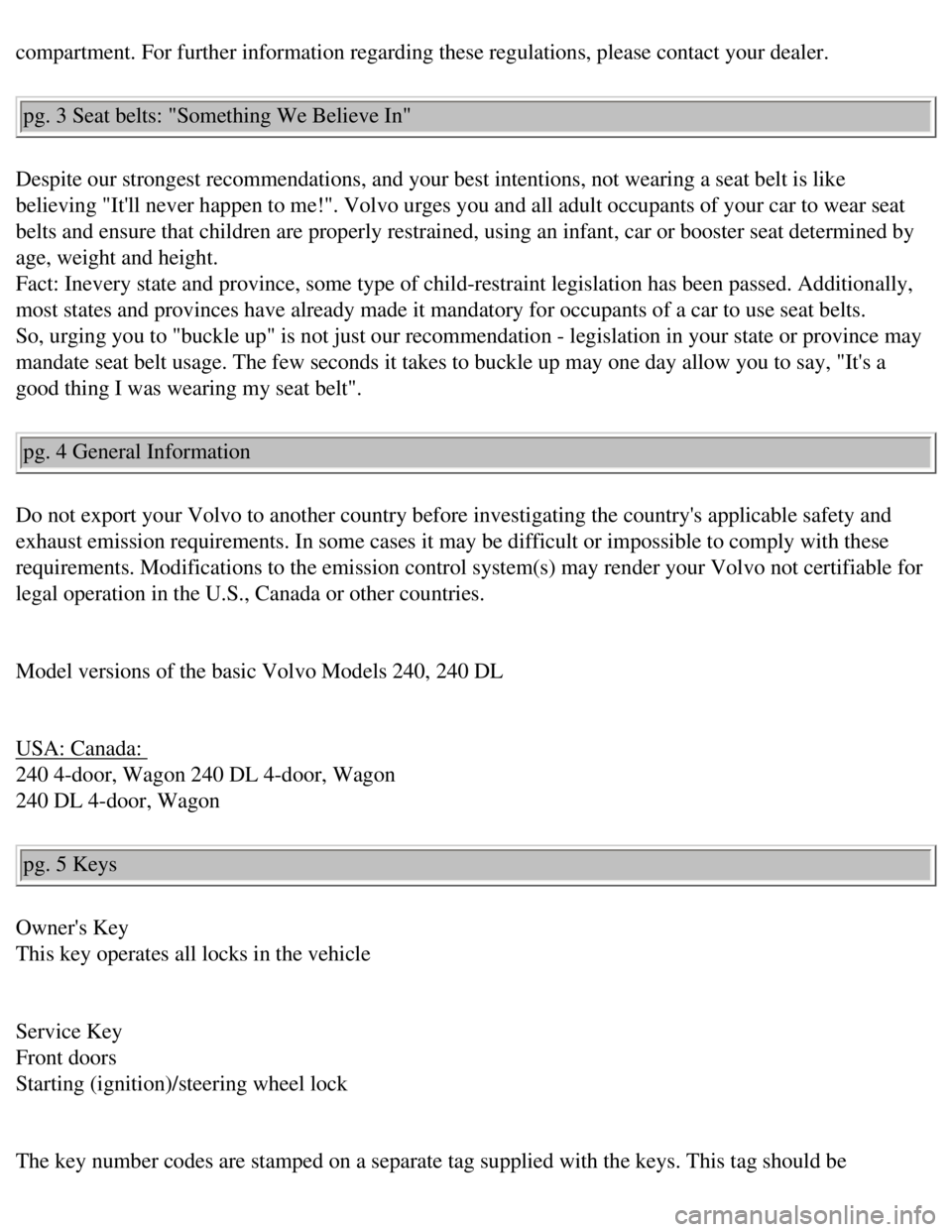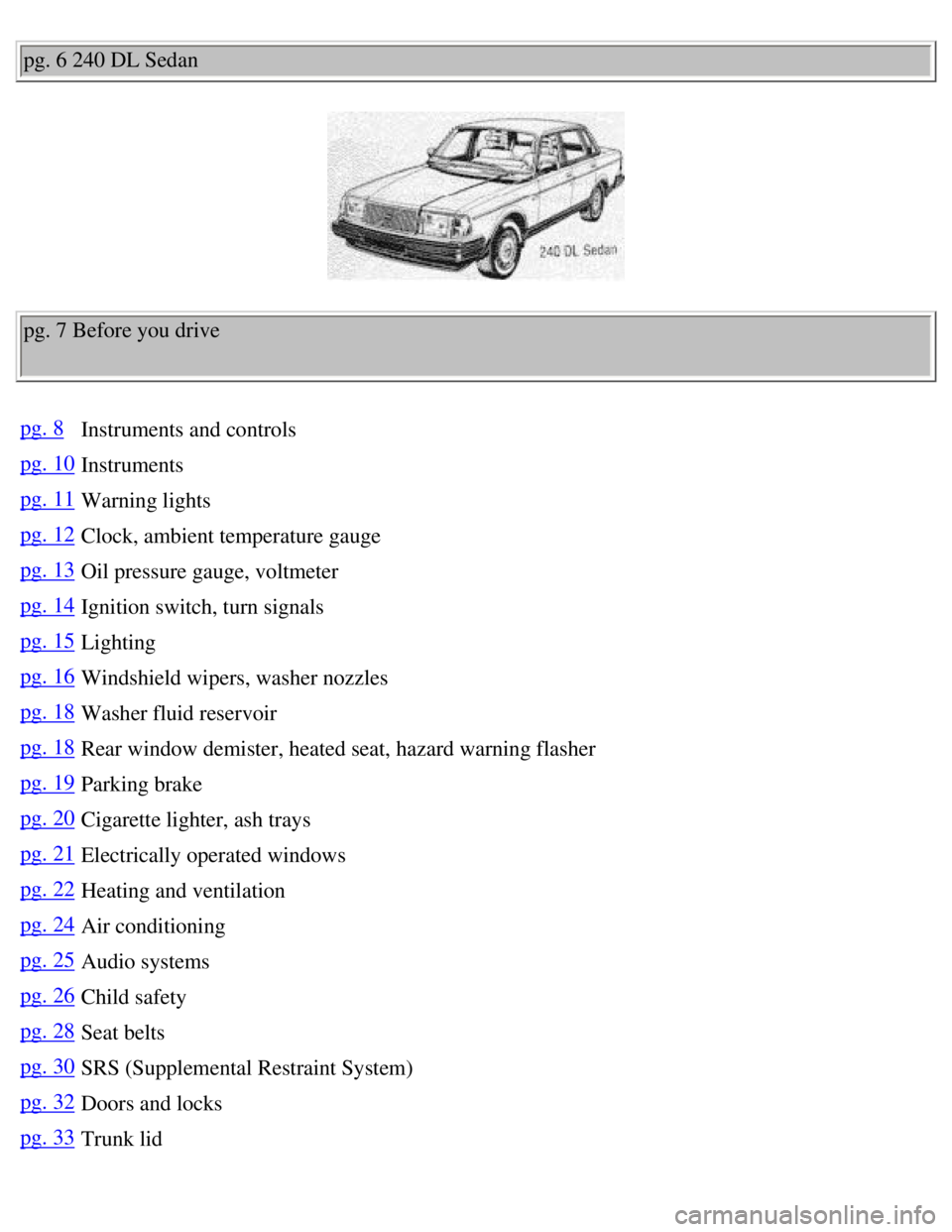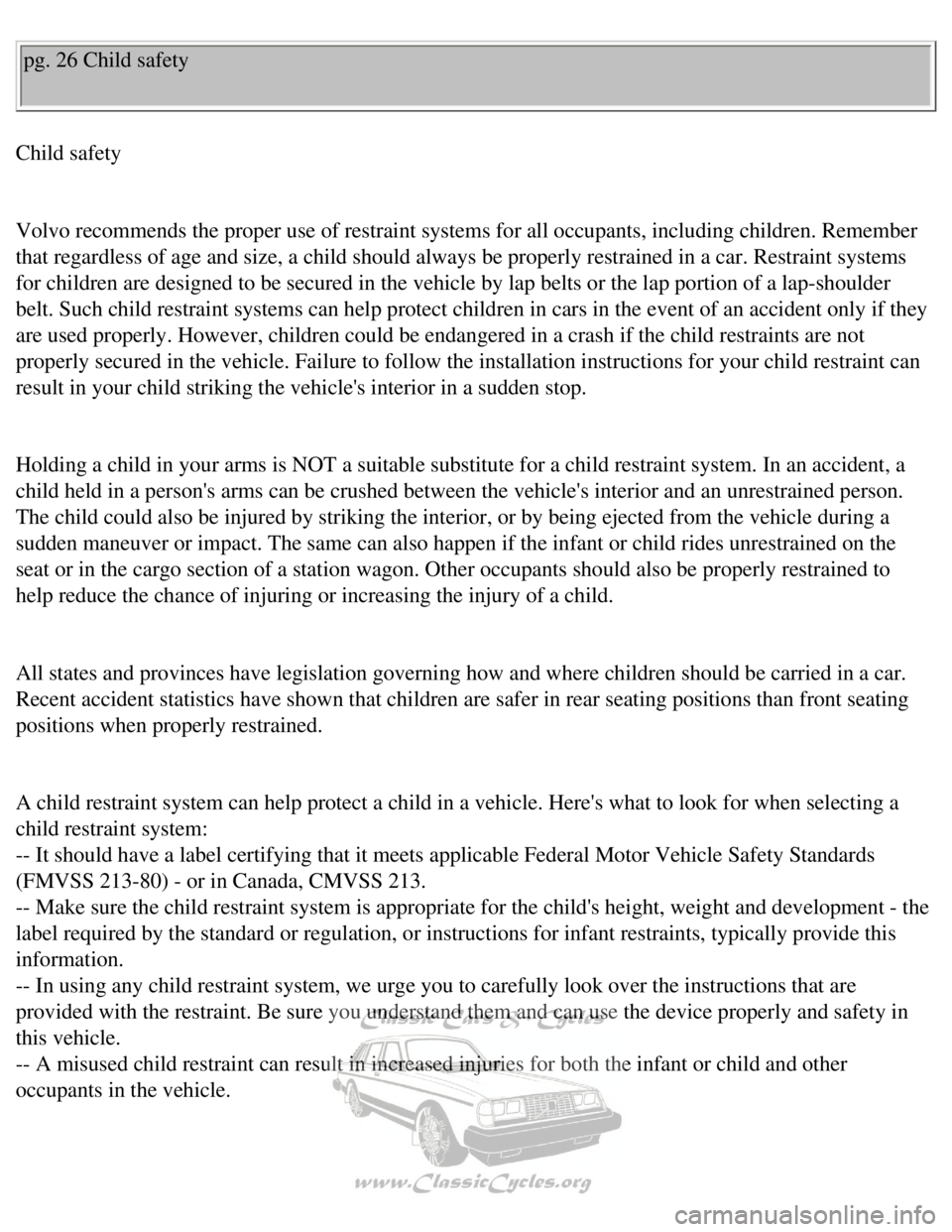1990 VOLVO 240 belt
[x] Cancel search: beltPage 2 of 143

Volvo 1990 240 Model
You should be familiar with the information in the first two chapters be\
fore you operate the car.
Information contained in the balance of the manual is extremely useful a\
nd should be studied shortly
after operating the vehicle for the first time. The manual is structured\
so that it can be used for reference.
It should thus be kept in the car for ready access.
All information, illustrations and specifications contained in this manu\
al are based on the latest product
information available at the time of publication. Volvo reserves the rig\
ht to make model changes at any
time, or to change specifications or design, without notice and without \
incurring obligation.
Introduction to the manual 2
Before you drive 7
This section provides a detailed description of the vehicle's instrument\
s and controls.
Operating the car 41
This section contains items such as starting the engine, operating gear \
selector, towing trailers.
Service and maintenance 53
An investment which will pay dividends in the form of improved reliabili\
ty, durability, and resale value.
Specifications 97
All specifications are subject to change without notice. Consult your Vo\
lvo dealer for information.
Should you require more detailed information please contact your Volvo d\
ealer. pg. 2 This manual deals with the operation and care of your Volvo
Welcome to the world-wide family of Volvo owners. We trust that you will\
enjoy many years of safe
driving in your Volvo, an automobile designed with your safety and comfo\
rt in mind. To ensure your
satisfaction with this vehicle, we encourage you to familiarize yourself\
with the equipment descriptions,
operating instructions, and maintenance requirements/recommendations in \
this manual. We also urge
you and your passengers to wear seat belts at all times in this (or any\
other) automobile. And of course,
please do not operate a vehicle if you may be affected by alcohol, medic\
ation, or any impairment that
could hinder your ability to drive.
Your Volvo is designed to meet all applicable safety and emission standa\
rds, as evidenced by the
certification labels attached to the door opening sheet metal and on the\
left wheel housing in the engine
file:///K|/ownersdocs/1990/1990_240/90240_00.htm (2 of 4)12/30/2006 8:\
25:01 AM
Page 3 of 143

Volvo 1990 240 Model
compartment. For further information regarding these regulations, please\
contact your dealer. pg. 3 Seat belts: "Something We Believe In"
Despite our strongest recommendations, and your best intentions, not wea\
ring a seat belt is like
believing "It'll never happen to me!". Volvo urges you and all adult occ\
upants of your car to wear seat
belts and ensure that children are properly restrained, using an infant,\
car or booster seat determined by
age, weight and height.
Fact: Inevery state and province, some type of child-restraint legislati\
on has been passed. Additionally,
most states and provinces have already made it mandatory for occupants o\
f a car to use seat belts.
So, urging you to "buckle up" is not just our recommendation - legislati\
on in your state or province may
mandate seat belt usage. The few seconds it takes to buckle up may one d\
ay allow you to say, "It's a
good thing I was wearing my seat belt". pg. 4 General Information
Do not export your Volvo to another country before investigating the cou\
ntry's applicable safety and
exhaust emission requirements. In some cases it may be difficult or impo\
ssible to comply with these
requirements. Modifications to the emission control system(s) may rend\
er your Volvo not certifiable for
legal operation in the U.S., Canada or other countries.
Model versions of the basic Volvo Models 240, 240 DL
USA: Canada:
240 4-door, Wagon 240 DL 4-door, Wagon
240 DL 4-door, Wagon pg. 5 Keys
Owner's Key
This key operates all locks in the vehicle
Service Key
Front doors
Starting (ignition)/steering wheel lock
The key number codes are stamped on a separate tag supplied with the key\
s. This tag should be
file:///K|/ownersdocs/1990/1990_240/90240_00.htm (3 of 4)12/30/2006 8:\
25:01 AM
Page 5 of 143

Volvo 1990 240 Model
pg. 6 240 DL Sedan
pg. 7 Before you drive
pg. 8Instruments and controls
pg. 10Instruments
pg. 11Warning lights
pg. 12Clock, ambient temperature gauge
pg. 13Oil pressure gauge, voltmeter
pg. 14Ignition switch, turn signals
pg. 15Lighting
pg. 16Windshield wipers, washer nozzles
pg. 18Washer fluid reservoir
pg. 18Rear window demister, heated seat, hazard warning flasher
pg. 19Parking brake
pg. 20Cigarette lighter, ash trays
pg. 21Electrically operated windows
pg. 22Heating and ventilation
pg. 24Air conditioning
pg. 25Audio systems
pg. 26Child safety
pg. 28Seat belts
pg. 30SRS (Supplemental Restraint System)
pg. 32Doors and locks
pg. 33Trunk lid
file:///K|/ownersdocs/1990/1990_240/90240_01.htm (1 of 5)12/30/2006 8:\
25:01 AM
Page 7 of 143

Volvo 1990 240 Model
5 Instruments 10
6 Wiper/washer, tailgate window wiper/washer (wagon) 16
7 Starting (ignition) switch/steering wheel lock 14
8 Air louver 23
9 Radio location 25
10 Air louver 23
11 Glove box -
12 Air louver 23
13 Fuse box 81
14 Hood release handle 34
15 Horn -
16 Cigarette lighter 20
17 Rear window demister 18
18 Hazard warning flashers 18
19 Air conditioning (some models) 24
20 Seat belt reminder light 28
21 Heating and ventilation 22
22 Gear lever or gear selector 45, 46
23 Ash tray 20
24 Storage compartment -
25 Electrically-operated windows (certain models only) 21
26 Control for electrically operated side mirrors (certain models only)\
-
27 Parking brake 19
28 Electrically-operated window, right front door (certain models only)\
21
29 Seat belt release buttons 28
30 Seat heaters 19
31 Seat belt reminder light 28
32 Ash tray 20
The pages in this section provide a detailed description of the vehicle'\
s instruments and controls.
Note that some vehicles may be equipped differently, depending on model,\
special legal requirements,
etc. pg. 10 Instruments
file:///K|/ownersdocs/1990/1990_240/90240_01.htm (3 of 5)12/30/2006 8:\
25:01 AM
Page 8 of 143

Volvo 1990 240 Model
A Clock
B Direction indicator (green)
C Speedometer
In kilometers and miles per hour (U.S. models)
In kilometers per hour (Canadian models)
D Odometer
Total reading in miles (U.S. models)
Total reading in kilometers (Canadian models)
E Temperature gauge
The gauge pointer should remain inside the black range during normal \
operation.
If the pointer enters the red range repeatedly, check coolant level a\
nd fan belt tension. (See sections
titled "Cooling system and coolant") Warning: allow engine to cool before adding
fluid.
Do not continue to drive the car with the pointer in the red zone.
F Fuel gauge
The fuel tank capacity is approx 60 liters = 15.8 US gals. See "Fuel \
requirements".
G Clock reset knob
H Service reminder light
I Check engine (red)
J Alternator warning light (red)
K Oil pressure warning light (red)
Do not drive the car with this light on.
L SRS (Supplemental Restraint System)
M Trip odometer reset knob Push in to reset
file:///K|/ownersdocs/1990/1990_240/90240_01.htm (4 of 5)12/30/2006 8:\
25:01 AM
Page 10 of 143

Volvo 1990 240 Model
pg. 11 Warning lights
The warning lights described on this page should never be on when drivin\
g
When the ignition is turned on, and before the engine starts, all of the\
warning lights should be on to test
the function of the bulbs. Should a light not go off after the engine ha\
s started, the system indicated
should be inspected. (However, the parking brake reminder light will no\
t go off until the parking brake
is fully released.)
Alternator warning light (red)
If the light comes on while the engine is running,
check the tension of the alternator drive belt as soon
as possible. (See section titled "Cooling system".)
NOTE: This warning light is illuminated if the
alternator is not charging. However, alternator,
parking brake, brake failure, and bulb failure will
be illuminated at the same time due to the design
of the system
Parking brake reminder light (red)
This light will be on when the parking brake
(hand brake) is applied. The parking brake lever
is situated between the front seats. Canadian
models are equipped with this warning light:
Bulb failure warning light (yellow)
The light will come on if any of the following bulbs
are defective:
one of the lower beams
one of the tail lights
one of the brake lights (when the brake pedal is
depressed).
See section on "Replacing Bulbs."
Oil pressure warning light (red)
If the light comes on during driving, the oil
pressure is too low. Stop the engine immediately
and check the engine oil level. See section titled
"Engine Oil". Do not continue to drive the car
with this light on.
After hard driving, the light will come on
occasionally when the engine is idling. This is
normal, provided it goes off when the engine
speed is increased.
file:///K|/ownersdocs/1990/1990_240/90240_02.htm (1 of 4)12/30/2006 8:\
25:02 AM
Page 32 of 143

Volvo 1990 240 Model
pg. 26 Child safety
Child safety
Volvo recommends the proper use of restraint systems for all occupants, \
including children. Remember
that regardless of age and size, a child should always be properly restr\
ained in a car. Restraint systems
for children are designed to be secured in the vehicle by lap belts or t\
he lap portion of a lap-shoulder
belt. Such child restraint systems can help protect children in cars in \
the event of an accident only if they
are used properly. However, children could be endangered in a crash if t\
he child restraints are not
properly secured in the vehicle. Failure to follow the installation inst\
ructions for your child restraint can
result in your child striking the vehicle's interior in a sudden stop.
Holding a child in your arms is NOT a suitable substitute for a child re\
straint system. In an accident, a
child held in a person's arms can be crushed between the vehicle's inter\
ior and an unrestrained person.
The child could also be injured by striking the interior, or by being ej\
ected from the vehicle during a
sudden maneuver or impact. The same can also happen if the infant or chi\
ld rides unrestrained on the
seat or in the cargo section of a station wagon. Other occupants should \
also be properly restrained to
help reduce the chance of injuring or increasing the injury of a child. \
All states and provinces have legislation governing how and where childr\
en should be carried in a car.
Recent accident statistics have shown that children are safer in rear se\
ating positions than front seating
positions when properly restrained.
A child restraint system can help protect a child in a vehicle. Here's w\
hat to look for when selecting a
child restraint system:
-- It should have a label certifying that it meets applicable Federal Mo\
tor Vehicle Safety Standards
(FMVSS 213-80) - or in Canada, CMVSS 213.
-- Make sure the child restraint system is appropriate for the child's h\
eight, weight and development - the
label required by the standard or regulation, or instructions for infant\
restraints, typically provide this
information.
-- In using any child restraint system, we urge you to carefully look ov\
er the instructions that are
provided with the restraint. Be sure you understand them and can use the\
device properly and safety in
this vehicle.
-- A misused child restraint can result in increased injuries for both t\
he infant or child and other
occupants in the vehicle.
file:///K|/ownersdocs/1990/1990_240/90240_06.htm (1 of 9)12/30/2006 8:\
25:04 AM
Page 33 of 143

Volvo 1990 240 Model
When a child has outgrown the child safety seat (approximately 4-5 year\
s of age, depending on size) you
should use the rear seat with the standard seat belt fastened. The best \
way to protect the child here is to
place the child on a cushion so that the seat lap belt is as far down on\
the hips as possible.
A specially designed and tested safety cushion for this purpose can be o\
btained from your Volvo dealer.
If necessary, an extra seat is available for use in the luggage compartm\
ent of station wagon models. This
seat is designed for two children, each up to 80 lbs. in weight and up t\
o 53 inches in height. pg. 27 Child safety
Child Restraint Anchorages
Volvo cars are fitted with child restraint top tether anchorages in the \
rear seat.
There are three anchorages under the rear section of the car's rear wind\
ow shelf on sedans and in the
back of the rear seat in wagons. When the car is delivered, the holes fo\
r these anchorages are covered by
plastic screws. In cars designated for Canada, one top tether anchorage \
set will be in the glove box. The
top tether anchorage set includes the top tether anchorage plate, an M8 \
bolt (30 mm long) and a plastic
trim cover. If another set is needed, consult your Volvo dealer.
Installing the top tether
Remove the plastic screw covering the anchorage point you want to use. T\
his can be done with a
suitable coin. The screw is removed counterclockwise.
file:///K|/ownersdocs/1990/1990_240/90240_06.htm (2 of 9)12/30/2006 8:\
25:04 AM